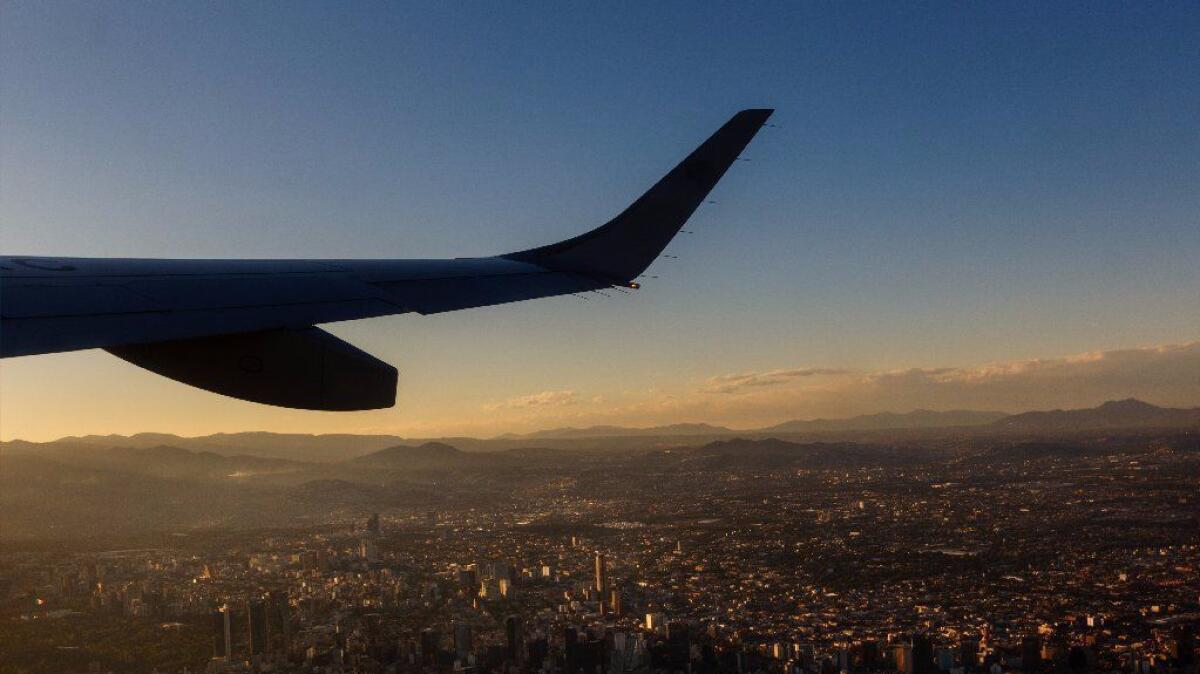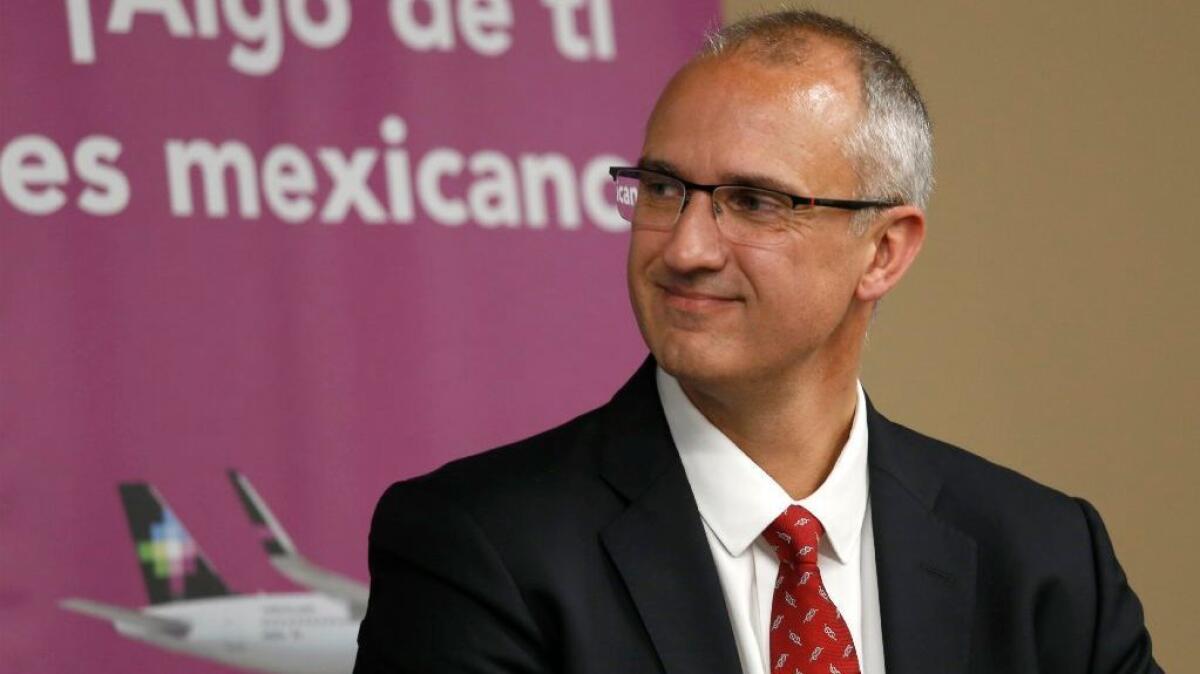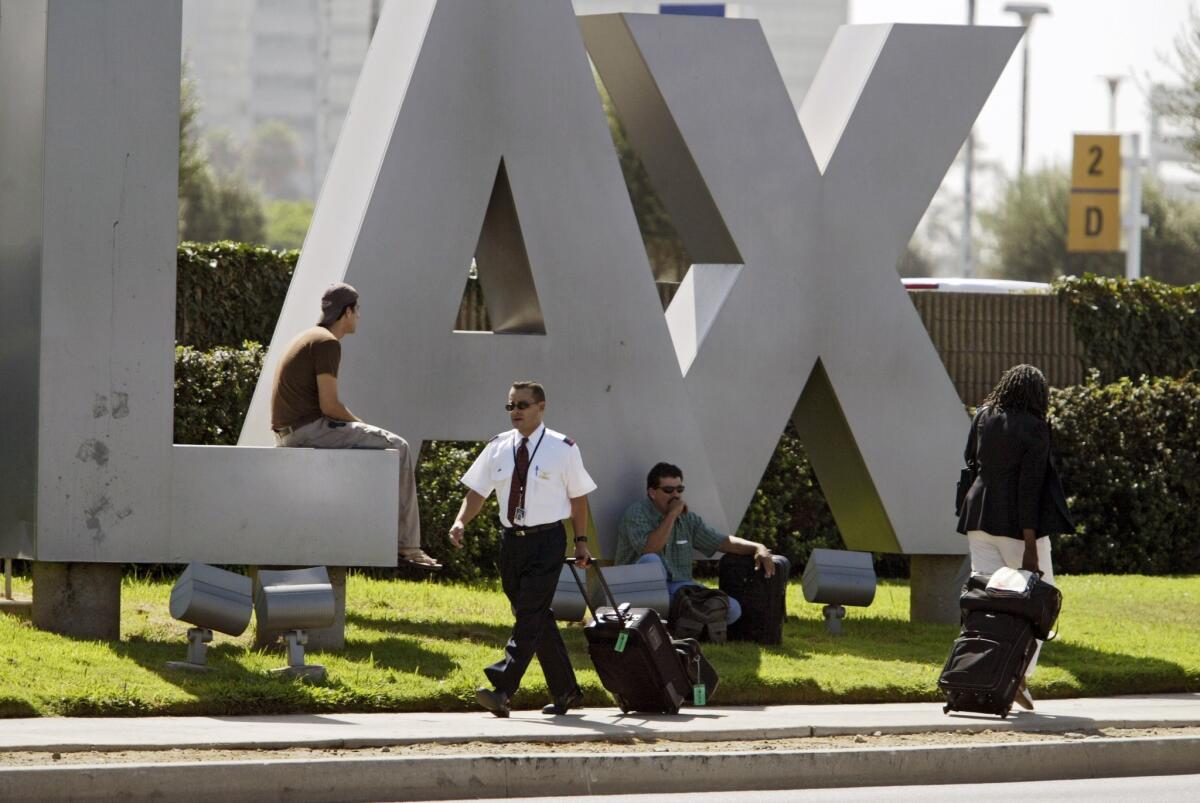What Trump effect? Airlines are adding routes to handle growing cross-border travel demand from Mexicans and Americans

The cushy business-class seats that Rosario MarĂn books on her regular flights between Los Angeles and Mexico are a far cry from those on the two-day bus journeys she took as a teenager to visit relatives in Mexico City.
A consultant for companies that want to do cross-border commerce, MarĂn says the bus trips of her youth were mostly crammed with families relying on the least expensive transportation within Mexico. Today, she shares airline cabins with business executives and tourists â and the accommodations are a distinct upgrade.
For the record:
1:09 p.m. Nov. 30, 2024A previous version of this story identified Rosario Marin as a former U.S. Treasury Secretary. She was the U.S. Treasurer.
âThere is no luxury when you are sitting in a small seat for two days,â quipped MarĂn, a former U.S. treasurer who was born in Mexico.
MarĂn is contributing to an increasing demand for air travel between the United States and Mexico attributed partly to growing business ties between the two countries and rising international tourism by Mexicoâs surging middle class. Then, thereâs the never-ending desire to visit family, which points to changing demographics in the U.S.
To serve the swelling market on both sides of the border, airlines including American, Alaska and Southwest recently added dozens of new routes or increased flight frequency to connect major business hubs and tourist hot-spots in both countries.
In December, Delta Air Lines will launch its first daily Los Angeles-to-Mexico City flights since 2005. That is on top of the five new nonstop U.S.-to-Mexico flights the Atlanta-based carrier announced in May, as part of a cooperation agreement with Aeromexico.

More and more people are willing and able to spend their pesos and convert them into dollars.
— Rosario MarĂn, business consultant, former U.S. Treasury Secretary
Beyond the predictable destinations, airlines are adding less-expected routes between the U.S. and Mexico including Los Angeles to LeĂłn and Atlanta to Queretaro.
Aeromexico this year expanded its daily nonstop service between industrial hub Monterrey, Mexico, and Detroit, described by the Mexico City-based airline in its announcement as âa U.S. city known for its development and promotion of the automotive industry.â
The increase in flights seems to defy travel industry predictions that President Trumpâs anti-immigrant rhetoric and plans to build a border wall would hurt travel and tourism between the U.S. and Mexico. Similarly, the Trump administrationâs push to undo the North American Free Trade Agreement raised concerns about a dampening of enthusiasm for cross-border commerce.
Discover Los Angeles, the tourism board for the region, was so worried that it launched an advertising campaign in April with the message âEveryone is Welcome.â
The fears have yet to be borne out.
âMore and more people are willing and able to spend their pesos and convert them into dollars,â MarĂn said.
Volaris, an ultra low-cost carrier based in Mexico City, has added nine routes between Mexico and the U.S. so far this year. JosĂŠ Luis SuĂĄrez DurĂĄn, chief operating officer for Volaris, attributes the new routes to a growth in the middle class in Mexico and the affordability of airline travel. He added that 8% of Volaris passengers are first-time fliers.
âOnce somebody flies, they become middle class,â SuĂĄrez said.

The middle class has become the fastest growing segment of Mexicoâs population, totaling 14.6 million households or 47% of the nation, as of 2015, according to Euromonitor International, the London-based market research company.
Mexicoâs middle class, defined as a household that earns between $15,000 and $45,000 per year, will continue to grow, adding 3.8 million more households by 2030, Euromonitor predicts.
Whatâs more, business ties between Mexico and the U.S. have continued to grow, 23 years after the North American Free Trade Agreement took effect.
That means executives and their workers need to book flights to inspect factories, meet with business partners and visit families across the border.
Grupo Bimbo, the Mexico-based bread producer, announced last month that it agreed to buy East Balt Bakeries in Chicago for $650 million.
Last year, Mexican diary giant Grupo Lala launched a U.S. division in Dallas, only three months after acquiring U.S. assets from Laguna Dairy for $246 million.
âThe growth of business coming here is going to continue because there really is the potential for profit,â said Josie Orosco, executive director of the Southwest chapter of the United States-Mexico Chamber of Commerce. âThey are making money. They wouldnât come here if they werenât making money.â
U.S. businesses are also investing in Mexico.
General Motors Co., for instance, announced this year that it will move production of its revamped GMC Terrain to Mexico from Canada.

Tourism has been strong, with visits from Mexico to the U.S. growing at an average rate of 5% per year from 2009 to 2016, according to the U.S. Department of Commerce.
Visitors from Mexico accounted for nearly 25% of all international arrivals to the U.S. last year, coming close to overtaking Canada as the top source of international visitors.
In January, more than 1.5 million visitors traveled to the U.S. from Mexico, a 2.4% increase over the same month in 2016, according to the U.S. Department of Commerceâs latest travel statistics.
Carlos Garcia de Alba, the Mexican consul general in Los Angeles, said Mexicans are drawn to the U.S. by family ties.
âThe most Mexican place outside of Mexico is Los Angeles,â he said during an event to celebrate Volarisâ new routes to Mexico. He added that visitors spend heavily on food, transportation and hotels during such visits.
âThe more connected Mexico is with Los Angeles, the better off we all are.â
MarĂn, who was appointed treasurer by President George W. Bush, said the added flights between the U.S. and Mexico show that the occupant of the White House has little influence on economic trends in Mexico and family ties between the two countries.
âWhat is happening in the market place has nothing to do with whoever is in power,â she said.
Although some travel across the border to shop or visit theme parks in the U.S., many come just to see relatives. The Latino population in the U.S. has surpassed 56 million. California and Los Angeles County have the largest Latino populations of any state or county in the nation, according to census figures.
Airlines on both sides of the border were given clearance to add more flights under an bilateral agreement reached last year between U.S. and Mexico to drop restrictions on the number of airlines that can fly between the two countries.
The deal, which took effect in August 2016, followed four years of negotiations. It means U.S. and Mexican airlines are limited only by the number of slots â a scheduled time to land or takeoff â available at various airports.
U.S. and Mexico-based carriers have scheduled 265,166 flights between the two countries for 2017, a 5% increase over the 252,813 flights that were flown last year, according to Airport Strategy & Marketing, an airline consultant.
As business connections expand between Mexico and the United States, airlines are likely to add even more routes linking Mexico and cities in the Midwest and Northeast, said Albert Zapanta, chief executive of the United States-Mexico Chamber of Commerce.
âIn the next three years, you will see airlines fly from Mexico to places we never even thought about,â he said.
Zapanta, who flies from Texas to Mexico at least once a month, said anti-Mexican rhetoric from the White House wonât kill real money-making deals.
âAt the end of the day,â he said, âyouâll get over it if you want to do business.â
To read more about the travel and tourism industries, follow @hugomartin on Twitter.
ALSO
North Korea tensions show the disconnect between Trumpâs words and administrationâs actions
Yuba City father of two gets 90 days to prepare for deportation to India
ICE in San Diego on pace to deport fewer people than last year, most without a criminal record
More to Read
Inside the business of entertainment
The Wide Shot brings you news, analysis and insights on everything from streaming wars to production â and what it all means for the future.
You may occasionally receive promotional content from the Los Angeles Times.











